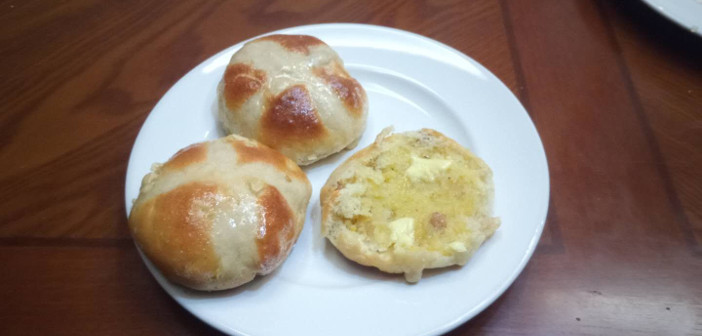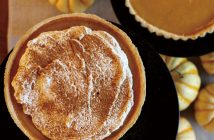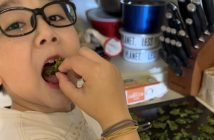Hot cross buns, hot cross buns,
One a penny, two a penny, hot cross buns,
If you have no daughters, give them to your sons,
One a penny, two a penny, hot cross buns…
This rhyme dates back to the 18th century, but the English have been eating buns with crosses marked on the top on Good Friday for over 600 years. They were made to celebrate the end of the Lent fast, and originally they were simply called “cross buns”, but the rhyme sung by street vendors selling them warm became so popular that “hot” became part of their name even when served cold.
You can buy hot cross buns in Beijing from Baker and Spice, and also from the charity Bread of Life. But following my adventures in mince pies last Christmas, I decided it would be fun to make some, using what I could get in Chinese supermarkets.
I based mine on Paul Hollywood’s recipe on the BBC Good Food website, but with one important difference. Hot cross buns are more like a sweet bread than a cake, relying on a great deal of kneading and proving. So for this, I turned to my trusty breadmaker.
I have a friend who mocks me for using a machine, and swears by getting your hands deep into the dough as a form of meditation or therapy. But he lives in a wealthy suburb of Brussels, with many traditional family bakers producing crusty baguettes every morning just down the road, and only bakes bread at the weekend. I, on the other hand, live in China, a country that refuses to accept any meaningful distinction between bread and cake. So I load up my Petrus 8500 each evening with flour, yeast, and the rest, and every morning we have fresh bread for breakfast.
So I started with 300 milliliters of milk, which I heated in a pan with a knob of butter (Hollywood calls for 50g, but I didn’t bother to measure.) When the milk came to the boil and the butter was melted, I put it in the breadmaker’s pan. I beat an egg and added it, then came 500g of flour; I used the same high gluten flour I use for bread. 75g of sugar (I used ordinary granulated white rather than the caster sugar from the original recipe), a teaspoon of salt and half a sachet of yeast complete the basic dough.
I set the breadmaker on the dough setting, which takes an hour and a half, giving me time to prepare the extras. I had 75g of sultanas (or possibly raisins or currants) left over from the mince pies, and I was also delighted to have a chance to use the candied peel I’d made. Sadly though, despite having originally been a method of preserving fruit over the winter, my peel had not survived four months in the fridge and had to be thrown away. So I replaced it with 50g of raisins (or possibly currants or sultanas.) An apple was easy to obtain and finely chopped, the zest of an orange grated in, and though powdered cinnamon is not readily available I simply grated a stick until the mixture smelled suitably festive.
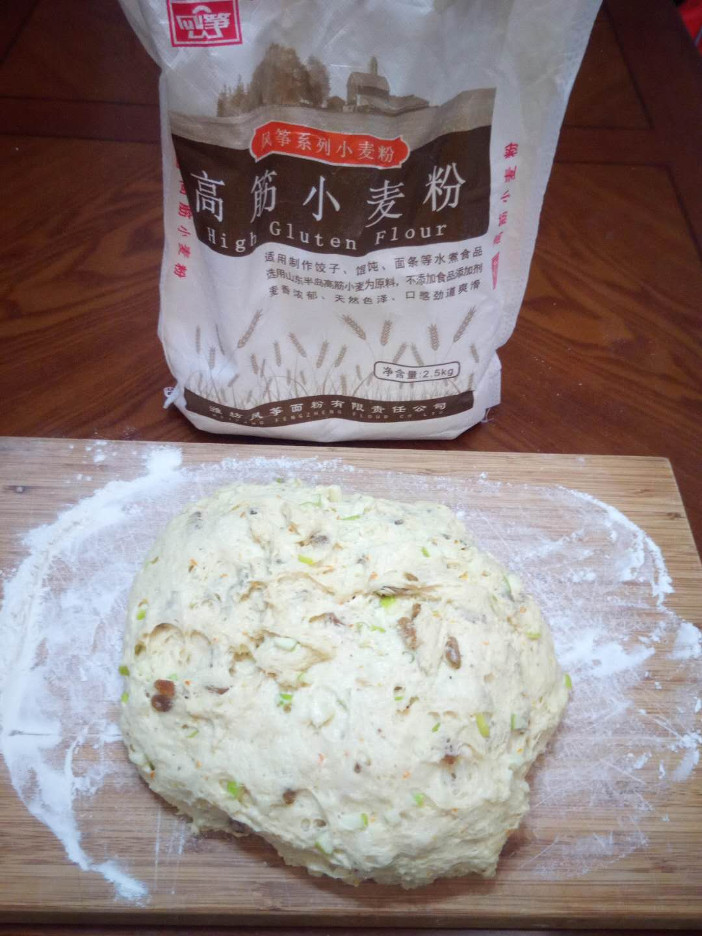
The mixed and risen dough, and the flour I used
When the machine beeped, I checked the dough, which had risen to fill the pan. I simply poked it down a bit and chucked all the fruit on top, then ran the kneading cycle again. Incredibly this worked, producing a big ball of dough with the goodies evenly mixed through. After another hour of raising I tipped it out onto a floured board. The recipe suggested dividing it into 15, but I went for 16 because it was easier to get the lumps more or less even. Having shaped 16 lumps into rough balls, I left them on a floured baking tray to prove for another hour.
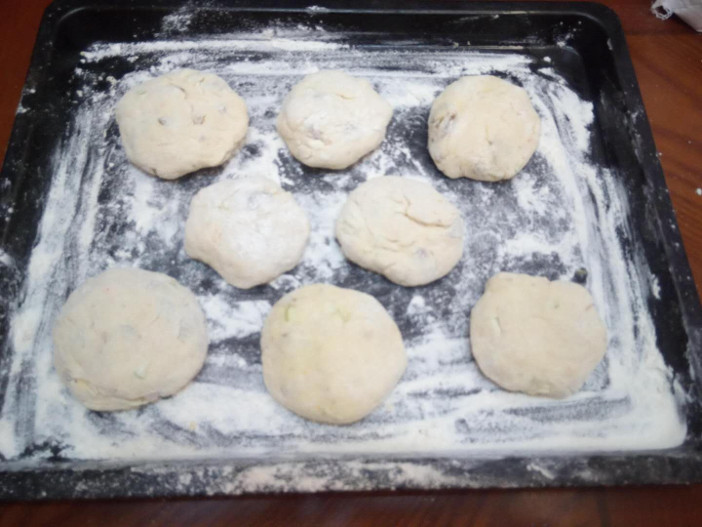
The buns before proving
The next task was to add the cross. I mixed about 60g of flour with 50ml water (a slightly more liquid combination than the recipe), but I had no piping bag, so ended up crudely painting the crosses on with a chopstick. The result, as you will see, was not aesthetically ideal:
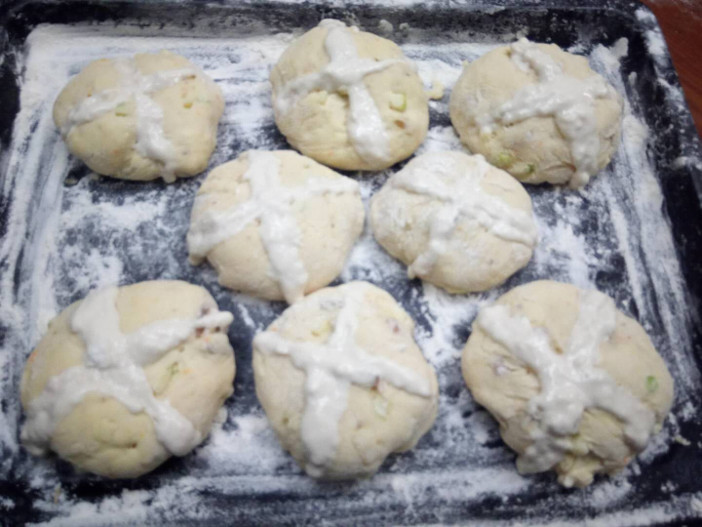
Yes, I know. But wait to see how they turn out…
The messy buns went into an oven preheated to around 175 degrees Celsius. Hollywood suggests a glaze made by warming apricot jam, but I had some honey which I bought from a mountain farm. It’s runnier than supermarket honey, either because it’s so genuine and natural or because I was duped by a crafty farmer who just fills jars with sugar water; so I just put it in a bowl on top of the oven to warm a little and painted it on with a pastry brush (which I do have). The results were more pleasing:
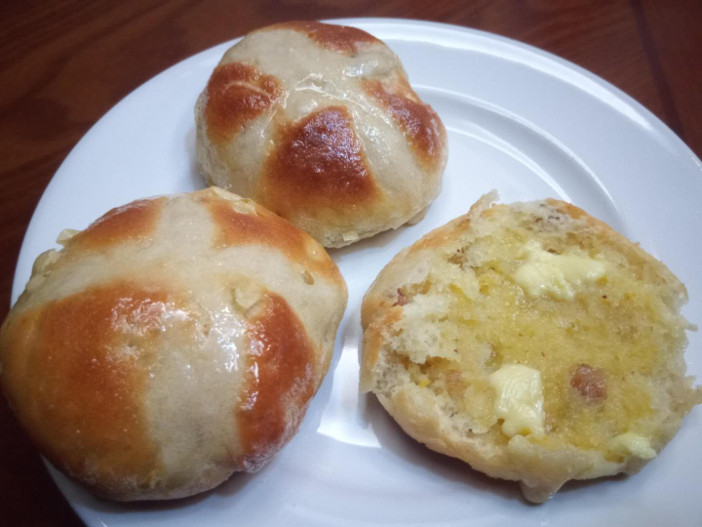
That’s more like it
More importantly, they were delicious, split open and buttered hot from the oven: not as sweet as commercial buns, even with the honey glaze, but fruity and richly textured. Enjoying one with a cup of tea, I was able to relax and consider the deeper questions of life. Such as, what kind of fool would buy a hot cross bun for a penny when you can get two for the same price?
Photos: Andrew Killeen

